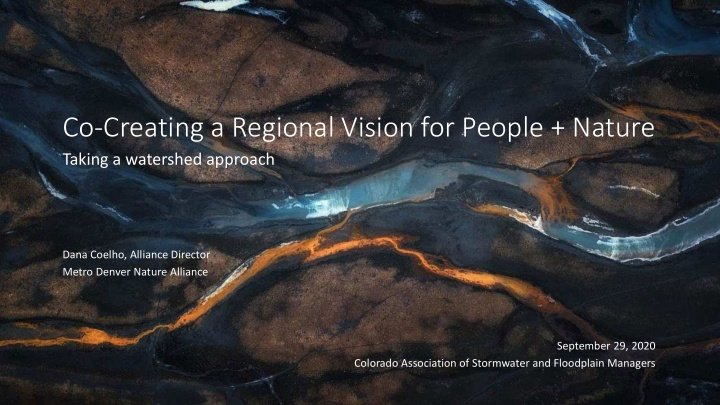



Co-Creating a Regional Vision for People + Nature Taking a watershed approach Dana Coelho, Alliance Director Metro Denver Nature Alliance September 29, 2020 Colorado Association of Stormwater and Floodplain Managers
Align nature-based efforts to ensure more equitable access to nature and to promote healthy people, communities, and natural places. Connecting Communities. Championing Nature. www.metrodna.org
In support of our mission & vision, Metro DNA performs three mutually reinforcing roles. Our work is rooted in both conservation + equity.
Climate Courage Heart of the West Counseling Jo Burns Consulting
Partner-led Collaborative Projects • City Nature Challenge: documenting observations of wild plants and animals; Wild Foundation, CO DNR, and TNC • Summit for Action: two-day workshop on Metro DNA-led solutions-based recommendations for Justice, • Nature Narratives: crafting and elevating a Equity, Diversity, Accessibility and Inclusion; Ecoinclusive shared story and partner voices • Rx for PRONTOS: a dialog prescription • Safe Summer Kick Off on Get Outdoors Day: programs for parks, recreation, outdoors, building community health, wealth, and nature, trails, and open space across the safety through connections to the natural state; Colorado Public Health and Parks & Rec world; partnership with SouthWest Denver Collaborative, CDPHE, and NPS Coalition, Denver Parks & Recreation, and National Park Service • Stewardship Mapping and Assessment • Regional Vision: Defining shared social- Project (STEW-MAP): understanding our environmental stewardship “landscape” – ecological goals and strategies to achieve who does what, where, and how are we all those goals; partnership with The Nature connected organizationally;Denver Urban Conservancy and Biohabitats Field Station
POPULATION GROWTH & SPRAWL 2050 4.8 M 2018 2000 3.5 M 2.7 M
Biohabitats
“We have confidence that [a] unified vision of conservation will result in significant progress over the long term. The coming together of nature conservation, historical preservation, ecosystem services, environmental justice and civil rights, sustainability, public health, and science communities is overdue, but when fully accomplished will reap significant reward. As these interests increasingly practice the skills of collaboration, and gain experience in working closely Jonathan Jarvis, Designing climate together in more common cause, they will find their resilience for people and nature at collective ‘voice’ to be powerful, influential, and the landscape scale, effective.” https://escholarship.org/uc/item/2mq6v6tn
Regional leverage existing data and planning documents to identify high-quality, Conservation connected, and climate-resilient habitat Assessment in the metro area
CPW Biohabitats Biohabitats
http://landscapeconservation.org/catalyst-fund/2019-catalyst-fund-grant-awards We all do better when everyone thrives. https://www.afcanatura.org/river-sisters http://www.sparcchub.org/communities
METRO DNA ECO REGIONS 1 Alpine Zone 2 Crystalline Mid-Elevation Forests 3 Crystalline Subalpine Forests 4 Flat to Rolling Plains 5 Foothill Grasslands 6 Foothill Shrublands 7 Front Range Fans 8 Moderate Relief Plains 9 Piedmont Plains and Tablelands 10 Pine-Oak Woodlands 11 Rolling Sand Plains
Project Timeline + Process Broader user group input on outcomes Conduct Develop Share Project Collect, Mapping & Detailed Outcomes coordination Process & Analysis Methodology and planning Share Data Conservation by Design Step: “Identify Challenges” Core Team – Prep of baseline materials Biohabitats
Project Timeline + Process Biohabitats
Project team + collaborators • Core Team: TNC, Biohabitats, and Metro DNA; meet weekly to coordinate all aspects of the project. • Leadership Council: decision makers from land and water management agencies committed to project implementation, meets 2-3 times per year. • Technical Advisory Team: technical experts from a range of institutions who will directly shape the analysis and project outcomes, meets once every other month. https://cmp-openstandards.org/about-os/os-what/
Project deliverables • Regional Conservation Strategy: portfolio of targets, metrics, and priority lands and waters to guide collaborative actions. • Biodiversity Atlas for decision-makers: publicly- available geo-database used to prioritize protection, restoration, and enhancement activities. • A diverse, engaged, and invested Leadership Council, Technical Advisory Team, and partner network. https://www.marc.org/Environment/Natural-Resources/Natural-Resources-Inventory/Natural-Resource-Inventory.html
Desired outcomes • Influencing how decision makers prioritize lands and waters to protect, connect, restore, and enhance; • Ensuring all people can have equitable access to nature and build community well-being; • Supporting wildlife in the face of a changing climate; • Creating a base of ecological knowledge to inform future policy, planning, and funding actions; • Deepening collaboration between key organizations in the region; and • Improving planning and decision-making through the development of shared goals, priorities, and metrics. Biohabitats
GOAL SCENARIO: Our job is to filter for decision-makers ! NATURAL HABITAT & Regional CONNECTIVITY Outcomes Regional Improved Water & Conservation Assessment REGIONAL VISION FOR Air Quality PEOPLE + NATURE • Close Coordination with Land Managers & Decision Makers Species • Science-Driven Assessment & Map of Preservation & Restoration Priority Areas to Protect, Restore, and • Provide decision-makers with information Enhance and strategies to efficiently incorporate Equitable Access • Key Focal & Indicator Wildlife Species conservation needs into policies. to Recreation & Nature • Combined, dynamic, and applicable vision SOCIAL VULNERABILITY & ACCESS for nature, natural infrastructure, access, Stable / Decreased Greenhouse Gas and land use for the Metro Denver region TO NATURE Emissions Decreased • Socioeconomic Status Mitigation & • Household Composition & Disability Restoration Costs • Minority Status & Linguistic Isolation • Housing & Transportation Shrinking • 10-Minute Walk to a Park Inequality Gap
www.metrodna.org/projects/trust-for-public-land-mapping-project/
https://web.tplgis.org/denver_mdna/
www.fs.usda.gov/rmrs/dufs-stew-map
Where does stewardship happen? 24 mapped areas
Network Visual 24 respondents named at least one group for a total of 183 different named groups.
PARTNER BENEFITS network connections, mission alignment and context within a shared vision, increased capacity, expanded reach, and leveraged Learn more + engage! www.metrodna.org/projects/regional-vision resources Become a partner! COMMON OUTCOMES www.metrodna.org/join more equitable access to nature, Dana Coelho, Alliance Director dana@metrodna.org | 303-883-9405 healthier people and places
Recommend
More recommend